Haemanthus coccineus
Haemanthus coccineus L.
Family: Amaryllidaceae
Common names: March flower, April fool, blood flower, paintbrush lily, powderpuff lily, king-of-Candia, pincushion (Eng.); bergajuin, bloedblom, rooikwas, bobbejaansool, koning-van-Kandie, Maartblom, misryblom, misryersblom, skoensole, velskoenblaar (Afr.)
Introduction
One of the surprises of late summer, with flowerheads like bright shaving brushes popping up from underground bulbs, is Haemanthus coccineus, which has a large number of variations and is one of 11 species of Haemanthus.
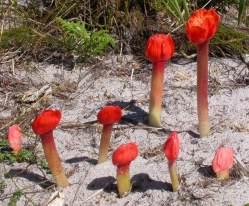
Description
Description
This is a very variable, perennial, geophytic species in which the laterally compressed bulb may be solitary or clumped.
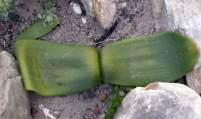
There are generally 2 leaves per bulb but occasionally 3. The leaves vary considerably in shape, size, colour and markings. They may be between 60mm to 700mm long and from 25mm to 210mm broad at the middle, but vary considerably depending on shape and location. They are elliptical to broadly or narrowly tongue- or strap- shaped (lingulate) most often more-or-less barred with red or dark green on the underside. They may be prostrate, recurved or may stand suberect.

The leaves generally occur after flowering, but rarely simultaneously with the flower, generally from autumn until spring, from about April to October, although some as early as February. Leaves die down from about October and the bulb lies dormant during summer.
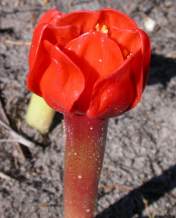
The flower heads emerge in late summer to autumn, between February and April, usually before the leaves appear. The peduncle is occasionally unmarked, but is most often more-or-less streaked or spotted. The flower head comprises 6-9 stiff, red spathe valves surrounding the 25-100 coral to scarlet flowers. The valves are mostly fleshy and may stand erect or sometimes be somewhat lax.
The flowers are soon followed by translucent, fleshy berries containing 1-3 dark wine-coloured seeds. The berries may be white to pale or deep pink in colour.
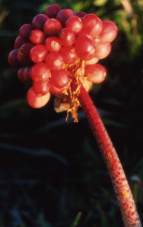
Conservation Status
Status
Not threatened.
Distribution and habitat
Distribution description
Occurs in widely varying habitats, mainly coastal scrub and rocky slopes, throughout the winter rainfall region of South Africa, from southern Namibia southwards to the Cape Peninsula and eastwards to Grahamstown. Population sizes may vary from a few plants in a group to dense stands in which there may be hundreds of individuals. They are found in karooid veld types as well as fynbos and renoster veld with rainfall ranging between 100 and 1 100 mm per year and altitudes from sea level to 1 200 m. They favour fairly protected sites such as rock crevices and shaded kloofs or the shelter of shrubs and bushes.
Derivation of name and historical aspects
History
The generic name Haemanthus is derived from the Greek word haima for blood, and anthos for flower, and alludes to the colour of the perianth in certain species. Coccineus is the Latin word for red or scarlet.
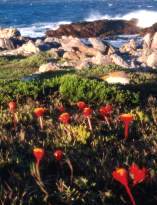
Some of the common names such as April fool or March lily refer to the flowering time, whereas others such as paintbrush lily and velskoenblaar refer to the appearance of the inflorescence or the leaves. The common name bloedblom is said to have been derived because of the opinion that it stops bleeding.
It was probably the first flower to be collected from Table Mountain and, probably also the first illustration of a South African flower to appearin a European publication. The illustration was by the Flemish botanis de L'Obel in 1605.
Ecology
Ecology
Like many other amaryllids, Haemanthus coccineus has adapted to the dry period of the year by resting underground in the form of a large bulb. (In the western Cape the dry season is summer.) All above-ground parts dry out during this time to help prevent moisture loss through transpiration. Just before the rainy season is due to start, the flowerhead appears. Sunbirds, noctuid moths and bees are the probable pollinators. Although the berries are fleshy, they are not eaten by animals. Once the seed has matured, the flowerhead topples over and the seed germinates immediately. Seeds have a very short viability period. By flowering and seeding in autumn, which coincides with the first rains, the seedling has a full rainy season to develop sufficiently to withstand its first dry period underground. Leaves usually appear well after the flowers. Because both the inflorescence and the leaves lose relatively large amounts of moisture, this adaptation prevents large quantities of moisture being lost at any one time, reducing stress on the plants.
Uses
Use
Fresh leaves were applied as a dressing to septic ulcers and sores and also to the pustules of anthrax. A diuretic was made from the sliced bulb boiled in vinegar and mixed with honey. Asthma was also treated with this mixture. The bulb contains coccinine which is an alkaloid with a known convulsive action.

Growing Haemanthus coccineus
Grow
Sow Haemanthus seeds in deep seed trays as soon as possible after harvesting in a very well-drained, sandy medium to which some fine compost is added. Press lightly into the soil, so that the top of the seed remains visible. Water well once and then again only after the first leaves appear. After that, water well once every two to three weeks. When the leaves begin to yellow, withhold watering altogether. Judicious watering starts again when the leaves reappear after the dormant period. Leave young plants in seed trays for at least two years before potting up individually into large, deep pots about 30cm in diameter. Select pots which will hold the mature plants, as they don't enjoy being disturbed again.
If planting into open ground, select a really well-drained position which only receives natural rains and is not influenced by artificial watering systems. This is truly a water wise plant! Also select a spot where, although protected, the flowerheads can be appreciated without being smothered or hidden by other plants.
Away from the winter rainfall region it would be best to treat this plant as a pot subject, so that watering can be carefully controlled.
Amaryllids can also be grown from offsets or from scales. Two publications in the Kirstenbosch Gardening Series, Grow bulbs andGrow nerines, both by Graham Duncan of the National Botanical Institute, give valuable propagation information.
Pests and diseases: These plants have a toxic principle which prevents them from being eaten by moles and mole rats. They suffer very few other problems.
References
- Cowling, R. & Pierce, S. 1999. Namaqualand — a succulent desert. Fernwood Press, Vlaeberg, Cape Town.
- Duncan, G.D. 2000. Grow bulbs. Kirstenbosch Gardening Series, National Botanical Institute, Cape Town.
- Duncan, G.D. 2002. Grow nerines. Kirstenbosch Gardening Series, National Botanical Institute, Cape Town.
- Manning, J., Snijman, D. & Goldblatt, P. 2002. The colour encyclopaedia of Cape bulbs. Timber Press, Portland, Cambridge.
- Pauw, A. & Johnson, S. 1999. Table Mountain — a natural history. Fernwood Press, Vlaeberg, Cape Town.
- Smith, C.A. 1966. Common names of South African plants. Memoirs of the Botanical Survey of South Africa No. 35.
- Van Wyk, B-E. & Gericke, N. 2000. Peoples plants. A guide to useful plants of southern Africa. Briza Publications, Pretoria.
- Van Wyk, B-E., Van Oudtshoorn, B. & Gericke, N. 1997. Medicinal plants of South Africa. Briza Publications, Pretoria.
Credits
Jane Forrester
Harold Porter National Botanical Garden
November 2003
Plant Attributes:
Plant Type: Bulb
SA Distribution: Eastern Cape, Northern Cape, Western Cape
Soil type: Sandy
Flowering season: Late Summer, Autumn
PH: Acid, Alkaline, Neutral
Flower colour: Red, Yellow, Orange
Aspect: Full Sun, Morning Sun (Semi Shade)
Gardening skill: Easy
Special Features:
Horticultural zones










Rate this article
Article well written and informative
Rate this plant
Is this an interesting plant?
Login to add your Comment
Back to topNot registered yet? Click here to register.